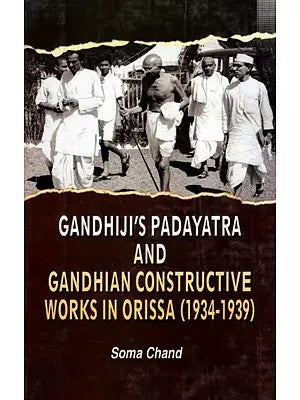Gandhiji's Padayatra and Gandhian Constructive Works in Orissa (1934-39) By Soma Chand
Gandhiji's Padayatra and Gandhian Constructive Works in Orissa (1934-39) By Soma Chand
Hardcover
Couldn't load pickup availability
Book Description
About the Book
In Gandhiji's Padayatra and Gandhian Constructive Works in Orissa (1934-39), acclaimed historian Soma Chand offers a profound exploration of Mahatma Gandhi's historic foot march in Orissa and the transformative constructive works that followed. Her distinctive narrative style brings the events to life, making complex historical contexts accessible to contemporary readers. Through vivid grassroots illustrations, Chand highlights how Gandhi's socialistic approach—rooted in non-violence and constructive programs—promotes social harmony amidst a world rife with materialism and ego-centric ambition.
As we celebrate the sesquicentennial of Gandhiji's birth, this book serves as a timely reminder of his intrinsic values and the relevance of his principles in today's tumultuous landscape. It calls for a blend of continuity and innovation in our quest for meaningful change, urging humanity to reflect on Gandhian ideals as a balm for our current challenges.
About the Author
Dr. Soma Chand is a distinguished academic and erudite scholar with a long-standing passion for writing. She has authored over 30 books covering various aspects of social science and literature, alongside around 50 research publications and more than 500 articles in newspapers and magazines. Currently the Head of the Postgraduate Department of History at Utkal University, Bhubaneswar, Dr. Chand’s work on Gandhiji adds valuable insights to the existing literature and serves as an essential resource for researchers and stakeholders alike.
Preface
Plato once noted that "there always are in the world a few inspired men whose acquaintance is beyond price." In our contemporary world, fraught with the threats of nuclear holocaust, terrorism, environmental degradation, and rampant exploitation, the issues of peace and sustainable development have taken center stage. Against this backdrop, the need for an alternative model of development becomes increasingly pressing. The Gandhian model emerges as a beacon of hope, emphasizing non-violent social change as its core tenet.
As noted by Ahangmage Turo Ariyaratne, a recipient of the Gandhi Peace Prize, "People would eventually realize with Gandhi that they need to fight not only with material poverty, but also with spiritual poverty." This reflection underscores the timeless relevance of Gandhiji's teachings in addressing the multifaceted challenges of our age.
Introduction
The name "Gandhiji" resonates profoundly within the fabric of our national identity. His innovative approach to politics—conceived as 'Freedom in its totality'—revolutionized the struggle for independence. With a unique blend of religious fervor and unwavering devotion, Gandhiji introduced concepts such as ahimsa (non-violence), Satyagraha (truth force), discipline, equality, and truthfulness, positioning him as more than a political figure; he became a social scientist and moral philosopher.
When Gandhiji emerged on the Indian political scene, the Indian National Movement had already established itself among the educated and professional classes. During his formative years (1915-1918), he seemed to navigate a solitary path, yet his distinct personality and political vision quickly garnered attention.
As Natesan eloquently expressed, "I could only join an organization to affect its policy and not to be affected by it." This illustrates Gandhiji's commitment to infusing new ideas into the movement, emphasizing that true change requires a dazzling new light. His innovative techniques of non-violent action became powerful tools for addressing injustices and resolving conflicts, illuminating the path toward independence until 1947.
In this work, we will journey through Gandhiji's Padayatra in Orissa, uncovering the profound impacts of his constructive programs and the enduring legacy of his philosophy in shaping a just and equitable society.
Share


